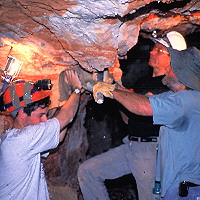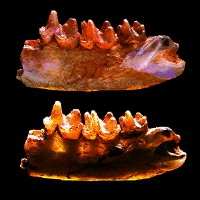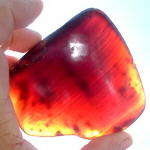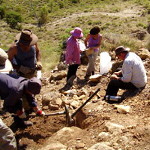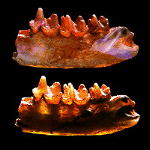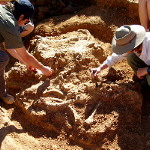|
Lightning Ridge research programTracking down our ancient relatives from the time of the dinosaurs110 million years ago the Australian landmass was connected to Antarctica, New Zealand and South America as the southern super-continent, Gondwana. Dinosaurs and their relatives dominated landscapes forested with pines, ferns and palms that were fringed by tracts of shallow sea. Here too, dwelt our rare and diminutive mammalian ancestors. At the edge of this ancient continent, fragments of the remains of these plants and animals accumulated in the sands of the seabed. Over millions of years mineral-rich water preserved these fossils molecule by molecule with hydrated silica: the building blocks of precious opal. Today deposits at Lightning Ridge in northern New South Wales yield some of the rarest, most beautiful and valuable fossils in the world. BackgroundThe sediments at Lightning Ridge were formed on the floor of an ancient shallow sea where plants, marine-life and occasionally the bones and teeth of animals were preserved. Over millions of years, mineral-rich waters from deep within the earth permeated this rock, transforming these fossils into opal. As they tunnel through these sediments searching for precious opal, miners sometimes find these fossils. Some of the most important fossils from Lightning Ridge are those of a special group of early mammals: the egg-laying monotremes. These animals were the ancestors of the modern Platypus and echidnas of Australia and New Guinea. The Lightning Ridge monotreme fossils provide a crucial link in our understanding of the history of this unusual group of animals: ancient survivors from the time of the dinosaurs. Mammal fossils are not often found in Cretaceous fossil deposits, since these generally rare and diminutive creatures were far outnumbered by the more successful and diverse dinosaurs. During the Early Cretaceous Period, 110 million years ago the Australian continent was much further south than it is today. its present day position. Australia was still connected to Antarctica and South America, which together formed the southern super-continent, Gondwana. At this time, much of Gondwana, including Australia, was well inside the Antarctic circle. The Cretaceous Period lasted from 141 million years to 65 million years ago, when mass extinctions wiped out many forms of life on earth, including all of the dinosaurs - with the exception of birds - and our own mammalian ancestors. |
Latest news
|

